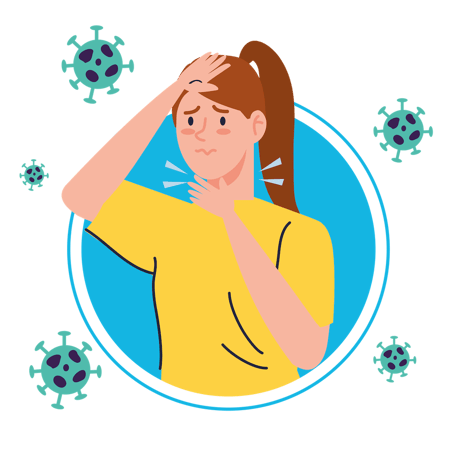 Coronavirus isn’t going anywhere anytime soon.
Coronavirus isn’t going anywhere anytime soon.
Unfortunately, even after a person recovers from COVID, they may still struggle with a variety of “long haul” symptoms months after the initial infection.
Scientists across the globe are working to understand just how individuals infected during the pandemic may experience the coronavirus long-term effects. Researchers and physicians are seeing patients with heart, brain, and lung damage from the virus, which can also increase the risk for long-term health issues, according to Mayo Clinic.
Given that almost one in four COVID-19 patients will have long-lasting symptoms, it’s essential to understand how it can impact them and those around them.
This post will cover what the most common long-term symptoms are, how those issues can impact the daily lives of those living with them, and ways employers can help employees through it.
What is Long-Haul COVID?
While most people are familiar with COVID, some haven’t heard about the much longer version of it, known as “post-COVID syndrome.” For many individuals, mild to moderate COVID-19 infections span about two weeks.
But when it goes beyond that, the live virus is gone from the body — meaning a person would test negative for the virus — yet they can still feel debilitating effects.The National Institutes of Health has identified these individuals as dealing with post-acute sequelae of SARS-CoV-2 or PASC for short.
The people who continue to deal with COVID symptoms long after their initial infection are also called “long-haulers.”
What Symptoms Do Long-Haulers Deal With?
Since viruses impact individuals all differently, symptoms for those with long-haul COVID vary from person to person. As scientists learn more about the virus, the symptoms may change or the list of possible symptoms may expand.
So far, this is the potential list of some of the long-term effects:
- Rash
- Pain
- Fever
- Cough
- Fatigue
- Myalgia
- Diarrhea
- Chest pain
- Headache
- Arthralgia
- Paresthesia
- Mood changes
- Abdominal pain
- Lightheadedness
- Increased respiratory effort
- Menstrual cycle irregularities
- Palpitations and/or tachycardia
- “Brain fog,” or cognitive impairment
- Insomnia and other sleep difficulties
- Impaired daily function and mobility
Those with several serious medical conditions, along with the elderly, are the most likely to experience lingering COVID-19 symptoms. But, young and healthy people can also feel unwell for weeks to months post-infection.
How Long Does it Last?
Scientists are still unsure of how long the “long-hauler” symptoms will last as the pandemic and the virus are still new. It will take some more time and understanding from studies to see how people recover to get a full understanding of the long-term impact of the virus.
What Are Some of the Long-Term Effects Long Haulers Have?
The symptoms of long-term COVID may indicate other underlying, more serious issues for individuals. Right now, the most commonly reported lasting symptoms include cough, shortness of breath, joint pain, chest pain, and fatigue, states the Centers for Disease Control and Prevention (CDC) website.
Specific issues that may impact your workers significantly include:
- Breathing issues - Difficulty breathing not only is a problem for keeping individuals conscious with optimal body functioning, but it can also cause anxiety. COVID-19 is known to cause scarring and permanent problems within the lungs. Even mild infections can cause ongoing shortness of breath. Recovery is possible — breathing exercises and respiratory therapy is known to help — but it takes patience and time.
- Neurologic problems - This unfortunate set of issues may include dizziness, headaches, fatigue, and brain fog.
- Mental health issues - Experiencing ongoing health issues can be stressful and overwhelming, especially for those who have never dealt with chronic illness before. For others who have additional health issues, it can compound worry and stress, too. For those who may have spent a prolonged time in the ICU, conditions like post-traumatic stress disorder (PTSD) can be a concern.
Combined with other issues like headaches and difficulty concentrating, it can make it a challenge for infected individuals to work like they used to, making it essential for employers to have a firm understanding of how the virus can disrupt even the most productive of workplaces.
How Long-Haulers Are Protected By Law
Because of the significant impact lingering COVID-19 symptoms may have on workers, the Biden administration announced in July 2021 that ADA and FMLA protections may be used.
While the announcement didn’t enforce a new law, a December 2021 decision by the U.S. Equal Employment Opportunity Commission (EEOC) – the federal agency that interprets and enforces the ADA in employment – announced it amended its COVID-19 guidance. The EEOC stated that certain instances of long-haul COVID may mean it’s a protected disability
The National Law Review in an article covering the EEOC’s decision states the following:
“The EEOC added some additional points regarding COVID-19 as a potential disability:
- Even if the individual is not now, and never was, actually disabled due to COVID-19, a person who has or has had COVID-19 can be an individual with a “record of” a disability if he or she has a history of, or has been misclassified as having, an impairment that substantially limits one or more major life activities.
- Likewise, an individual who is not disabled due to COVID-19 may nonetheless be regarded as having an impairment because of a mistaken belief on the employer’s part, whether as to the person’s status as infected or as to the scope of the impairment resulting from infection. For example, if an employer fires an individual for contracting or having symptoms of COVID-19 because the employer presumes he or she will be impaired for many weeks or months, the individual may claim protections as a person regarded as disabled.
- Even if an individual’s COVID-19 status may not alone constitute a disability, if the individual’s underlying condition is exacerbated by COVID-19 (for example, an individual with well-controlled diabetes before COVID whose symptoms are worsened by the virus), or the COVID-19 virus causes an impairment (for example, the virus causes heart inflammation which affects circulation), that underlying-but-exacerbated condition or resulting impairment may constitute a disability.
Potential coverage under the ADA is a starting point; as always, requests for accommodation should be carefully considered and, given the rapidly developing nature of COVID-19-related conditions, consultation with counsel is encouraged.”
How Your Company Can Support Long-Haulers
In the pandemic era, employers have plenty on their plates to juggle.
Between figuring out staffing shortages, vaccination requirements, workplace health safety protocols, and then adding in supporting loyal, but still-sick employees, it can feel overwhelming.
Here are some resources and ways to support your long-hauler employees:
- Review accommodations - Now is the time to look over your current accommodations for ADA at work. As employees come back to work, ensure policies and procedures are active to support long haulers as they manage ongoing symptoms and complications. Think about how physical and mental demands may be an issue for individual workers in their roles.
- Establish work from home protocols - If you haven’t already, it’s time to set up and organize your company’s work from home protocols. Remember that if you allow long-haulers to work from home, it’s your responsibility to make an effort to help workers set up an ergonomically correct home office space.
- Encourage healthy behaviors - Keep your wellness programs at the forefront of your employees’ minds. A healthy body and mind makes it easier to fight off infections. Research indicates those with obesity and other chronic conditions are more likely to experience long-hauler symptoms, too.
- Keep sick individuals out of the workplace - For those employees already dealing with chronic illnesses, another infection can take its toll even further. Screen workers and use local public health and CDC guidance to determine whether ill individuals would pose a direct threat to health in the workplace.
- Remind workers about benefits - Specific benefits like short-term disability and FMLA can relieve anxiety and help workers suffering through coronavirus long-term effects. Reducing their financial impact of working less can help their mental health significantly.
- Provide workers with resources - Aside from encouraging your impacted employees to work closely with their primary care provider, give them valuable resources, too. Sites from reputable organizations like the CDC, National Institute of Health and Harvard Health update their content often to reflect the most updated research on COVID-19 long-term effects and symptoms.
Finally, keeping in the loop about disability requirements and networking with other human resource individuals and C-suite executives can also offer insight on creative and useful ways to support your staff. Collaborate and raise awareness about ways to support workers in this new working world we’re living in.
What coronavirus long-term effects have you seen interrupt the workplace? How are your employees handling them with your support? Share your insight in the comments below.



